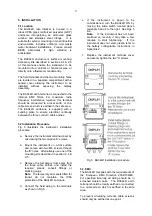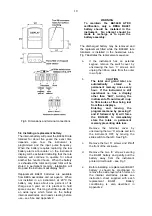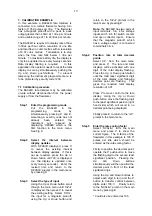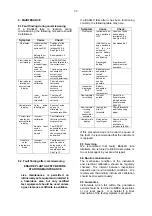
7
4. SYSTEM DESIGN FOR HAZARDOUS
AREAS
When mounted in a hazardous area the
BA344D can operate as a stand alone rate
totaliser without the need for Zener barriers or
galvanic isolators as shown in Fig 2.
Fig 2 Stand alone operation within hazardous
area
The voltage pulse input terminals 3 and 4 may
be directly connected to any certified
intrinsically safe voltage source within the
hazardous area which can withstand a 500V
rms insulation test to earth for one minute and
has output parameters equal to or less than:
Uo
=
28V dc
Io
=
100mA dc
Po
=
0.7W
This enables the BA344D to be connected
directly to most flowmeters incorporating a
certified intrinsically safe magnetic pick-off, or
a certified intrinsically safe amplifier producing
a high level pulse output. The maximum input
counting frequency is 10kHz.
Any mechanically activated switch contact
located in the hazardous area may be directly
connected to terminals 5 & 6 providing the
switch and associated wiring have IP20
protection and can withstand a 500V rms
insulation test to earth for one minute. This
allows most magnetically activated reed relays
used in turbine flowmeters to be directly
connected to terminals 5 & 6. The BA344D
contains filtering to prevent contact bounce
being counted which limits the maximum
operating frequency for a switch contact to
100Hz.
Similarly, an open collector transistor with
certified segregation, such as those used in
intrinsically safe opto-isolators may be directly
connected to terminals 5 & 6. The maximum
input counting frequency is 10kHz.
4.1 System certificates
When the input signal is derived from the safe
area or the total display is to be reset from
within the safe area, Zener barriers or galvanic
isolators are required to transfer the signals in
and out of the hazardous area.
In addition to the ATEX EC-Type Examination
Certificate, ITS have issued two system
certificates. One defines how the BA344D may
be used with Zener barriers and the other with
galvanic isolators. Both are divided into two
sections to cover input signal sources in the
hazardous and in the safe area.
Interface Certificate No
Zener barriers
Ex01E2018
Galvanic isolators
Ex01E2019
This section interprets these system
certificates and illustrates how to design
systems with Zener barriers and galvanic
isolators.
System certificates are Certificates of
Conformity which are primarily issued for
guidance in the UK. They do not form part of
certification to the European ATEX Directive.
4.2 Use with Zener barriers
Zener barriers are the least expensive
intrinsically safe interface between a safe and
hazardous area. However they do not provide
isolation and require a high integrity earth
connection that may be expensive to install.
For a single BA344D it may be less expensive
and complicated to use galvanic isolators when
a high integrity earth connection is not already
available.
Any certified Zener barriers may be used with
the BA344D providing their output parameters
do not exceed the input parameters of the
terminals to which they are connected. Only
one polarity of Zener barrier i.e. positive or
negative , may be used with each instrument.
Summary of Contents for BA344D
Page 13: ...13...






















